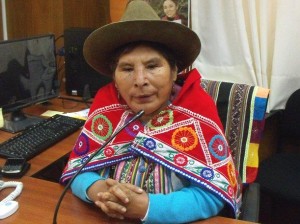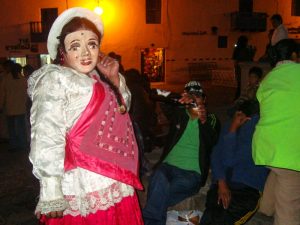Two-Gendered Paisana Jacinta and Racism

Peru’s popular culture holds many difficult and troubled images. Most recently, one of them, the very popular Paisana Jacinta was driven from the airwaves when an indigenous congresswoman, Hilaria Supa, protested it and the United Nations Committee for the Elimination of Racial Discrimination declared it offensive. In response, Frecuencia Latin canceled the Paisana Jacinta program.
Ostensibly, Paisana Jacinta was a rural, indigenous woman who had migrated to Lima. The figure, created by humorist Jorge Benavides Gastello, provoked severe criticism in this, its third, appearance on Peruvian television. José Ávila Herrera, the Viceministro de Derechos Humanos y Acceso a la Justicia de Perú (Undersecretary of Human Rights and Access to Justice of “definitely denigrates the cultural identity of many of our women from indigenous communities.”
Congresswoman Hilaria Supa, from Cuzco’s Anta Province, used similar language to challenge the program.
“It is wrong that in the 21st Century, when we thought we had progressed, that we see racist attitudes [against indigenous people] in stadiums, public places, schools, and the media, such as Frecuencia Latina, that offend us as citizens. These include programs such as Negro Mama or Paisana Jacinta.” . . . ” These programs denigrate us. They make us look stupid, careless, and that must stop.”

In part, the congresswoman was referencing Paisana Jacinta tours around the country in various stadiums. However she was also referencing a broad popular culture of negative images and discrimination commonly found in urban Peru’s dealings with indigenous people. While some of these images are of recent derivation, such as Benavides’ Paisana Jacinta, others have deep and ancient roots.

Nevertheless, activists such as Hilaria Supe and the organization CHIRAPAQ, the Center for Indigenous Cultures of Peru, actively challenge the place of these stereotypes and the ways they subordinate indigenous culture and people in a hierarchy that takes away their humanity and aspirations.
At the same time, it is worth noting there is a complexity in many of these images that goes beyond simple racism. For example, the Paisana Jacinta has been taken as an attack on Indigenous women. Yet the issue is not quite so simple, even if most people take her as a woman. Indeed, understanding the complexity helps refine our grasp of how the racism works.
Paisana Jacinta wears her lliqlla, her traditional carrying cloth, over one shoulder and under another, unlike women who cover both shoulders with their lliqlla.
This is the traditional way a man would wear a carrying cloth. When combined with other articles of female dress this is the sign of a waylaca.

A figure found in many traditional dance troupes of Cuzco, the waylaqa is neither strictly male nor female in the traditional sense, it is both. However, the word is also an insult when applied to woman, as it suggests an incompetent and even undignified woman.
In this sense, the denigration carried out by the Paisana Jacinta is not just that it portrayed indigenous women as “stupid and careless”, it also accused indigenous women of being waylacas and not quite real women, such as the urban, Hispanic women also shown in the program.
The value and quality of indigenous women disappear in a half-woman figure, a mixed gender, rather than allowing the full indigenous woman to appear, both shoulders covered, with dignity, pride, and value.
In this sense, it is the appropriation of a waylaca by urban Peru and its use to make disappear the value of traditional women that creates the issue, at once sexist and racist.
Waylacas continue in Cuzco’s culture of feasts and dances, as they should. They are not the same as the Paisana Jacinta, an urban and Hispanic taking of mixed-gender culture, when they are indigenous representations and workings of gender and identity.
http://www.larepublica.pe/25-08-2014/la-paisana-jacinta-ya-no-va-mas-en-frecuencia-latina





Does the trans community do anything with the waylaca?
Hi Natalie,
This is a wonderful question and one to which I do not know the answer. The whole question of the trans community in Cusco is a complex one and one I ought. This would be fun to look into. You should come to Cusco and help us do it.